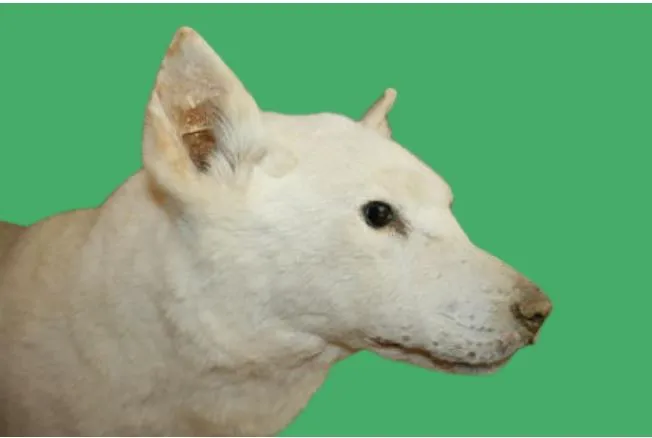Whina Te Whiu, Curator, Te Ahu Museum
Bushy-tailed, strong shouldered and stumpy legged, the extinct kurehe/kurī is rarely found in museum collections.
Having gone extinct sometime in the 1860s there are only a handful of stuffed specimens, vials of fur and collected bones that remain of this species which was the only domesticated animal of early Māori.
The remains of the last known specimens, a female and her pup, are now in the collection of the Museum of New Zealand Te Papa Tongarewa. Our small museum up in Kaitaia, Te Ahu Museum, is fortunate to include a fine example of a kurehe in its collections.

Kurehe were brought to New Zealand by early Māori settlers, and not many examples have survived for public display – Te Papa also holds only one full specimen.
Kurehe are traced back to the voyages of Kupe. Two stories stand out – than one kurehe leapt out of the Tokomaru canoe one night, and guided Māori to Aotearoa with its howling; and that Kupe left his kurehe Tauaru on the heads at Hokianga so long that it turned to stone.
If you look closely, you can still see the stones that sit at the mouth of the Whirinaki river in the shape of a dog.
Often having a startling white fur, the kurehe was important to Māori in many ways.
These included for companionship; to assist with hunting, gathering kiwi, pukeko and other birds; for cloaks; and a ceremonial food source, with Cook proclaiming the taste to be as good as lamb.
Cook also recorded his observations of kurehe being in waka which paddled out to greet the Endeavour. He wrote favourably of their appearance and condition, and notably about their clear role as a close and beloved companion of Māori
The kurehe at Te Ahu is remarkably well-preserved. The skeleton was found by Vic Hensley at Kaimaumau (East Beach), a stunning spot hidden away on the north side of Rangaunu Harbour about 30 minutes north of Kaitaia.
DNA sampling on some of the few kurehe specimens located across Aotearoa indicate the dogs had a rich diet consisting of seafood, birds and plant life. This DNA analysis has also helped link species back into the Pacific suggesting voyaging routes early Māori travelled. Analysis of teeth and skeletons has revealed useful information about butchery techniques, and the diet and behaviour of the dogs.
There is a lack of archaeological evidence to confirm why the kurehe became extinct; perhaps because it was a food source, and as a source of adornment for prized dog skin cloaks, kahu kurī and weaponry; or the arrival of other dog breeds with hunters, traders and early European settlers. Interbreeding between species may have helped lead to the eventual eradication of the kurehe.
The team at Te Ahu is proud of its kurehe specimen. It provides a link back to the time of Kupe, and the discovery of Aotearoa. It also provides insight into the life and domestic arrangements of Māori living in the district.
But the discovery of the specimen also tells its own story: that beneath the sands of the Far North lies a history going back centuries, some uncovered, some lying in wait, all possessing the power to tell us something new about the origin and development of this amazing land.
References:
Elsdon, Best (1924) , The Maori (volume 1), Kuri, Maori or native dog - Dominion Museum Collection.
Kahu Kurī - Tales from Te Papa episode 3, Te Papa Tongarewa
Macdonald, Nikki, Why did the Maori dog kurī die out? Scientists looks for clues in old hair and bones, Stuff (2019)
A dog's life: the fate of Māori kurī, University of Auckland (2022)
Kurī in archaeology, Auckland Museum
Basil Keane, 'Kurī – Polynesian dogs', Te Ara - the Encyclopedia of New Zealand, (accessed 18 May 2023), published 24 Nov 2008
Kurī - Polynesian dogs, Te Ara
Featured Museums
-

Organisation
Museum of New Zealand Te Papa Tongarewa
-

Organisation
Te Awamutu Museum
-

Organisation
Te Ahu Museum and Archives
-

Organisation
Auckland War Memorial Museum



